
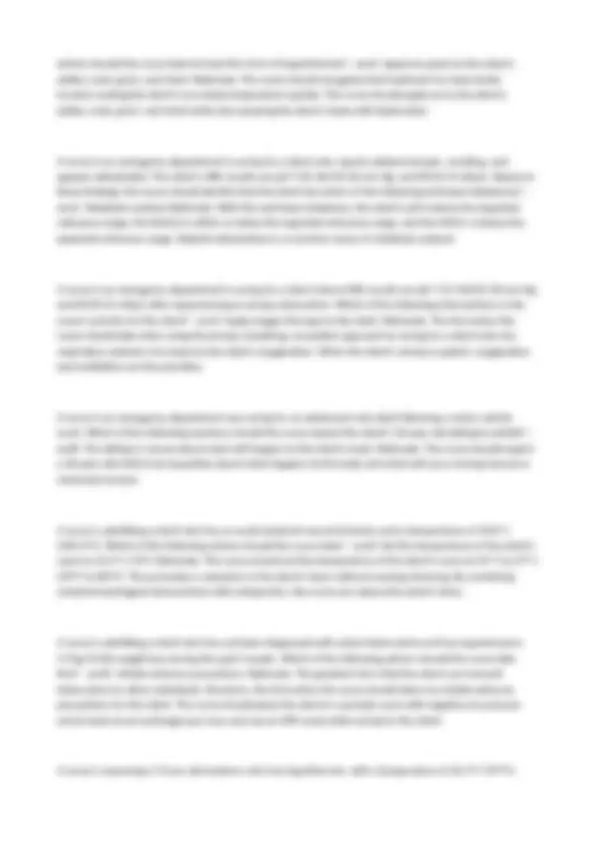
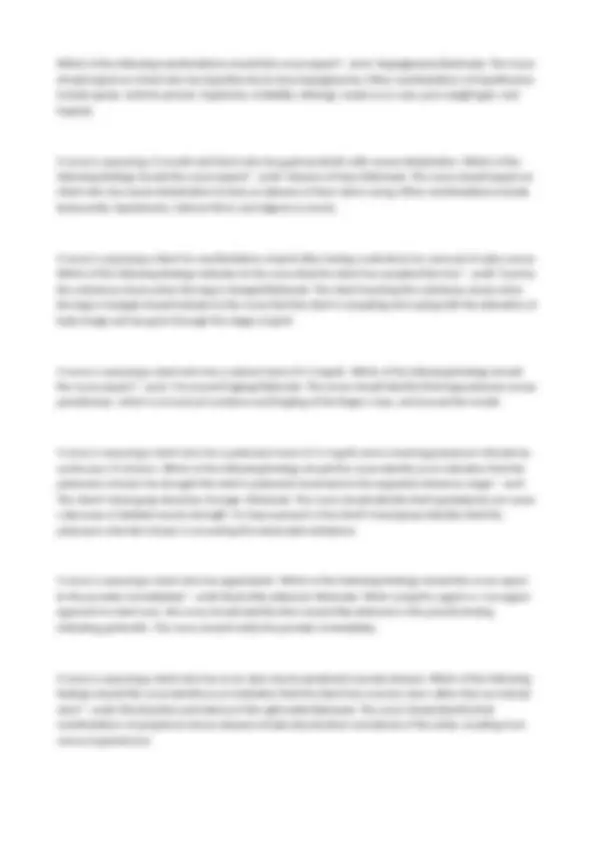
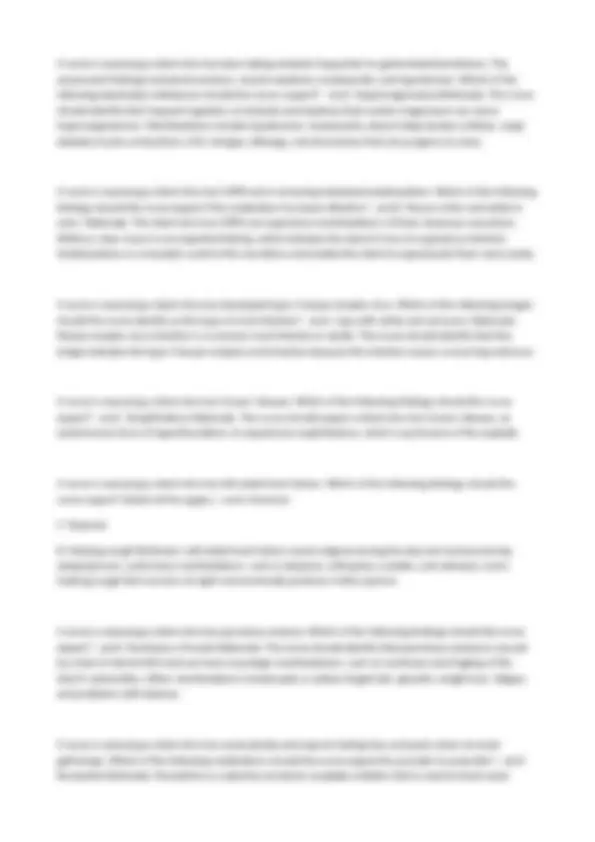
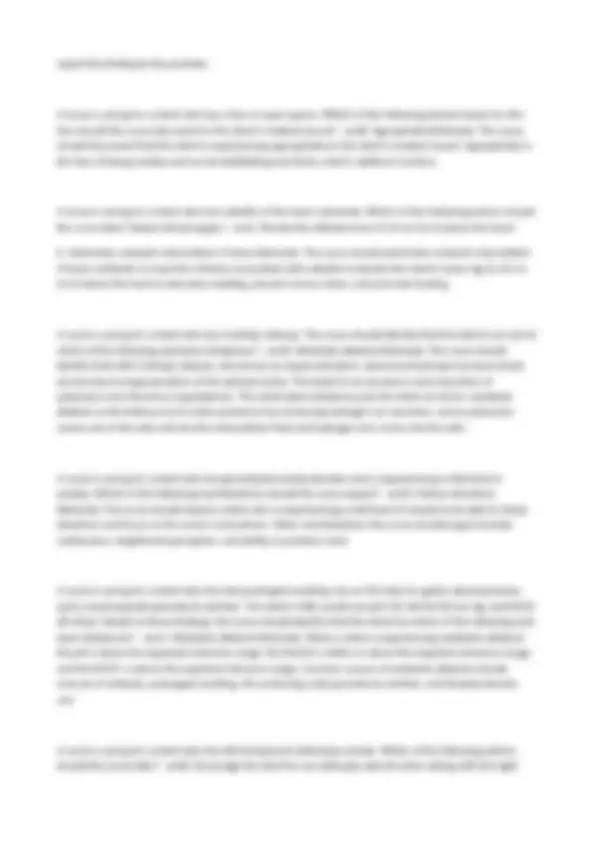
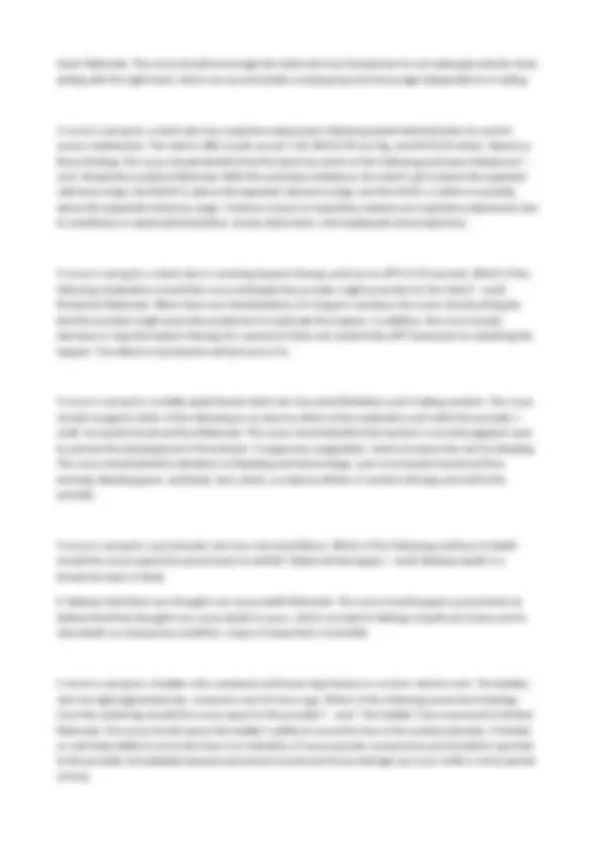
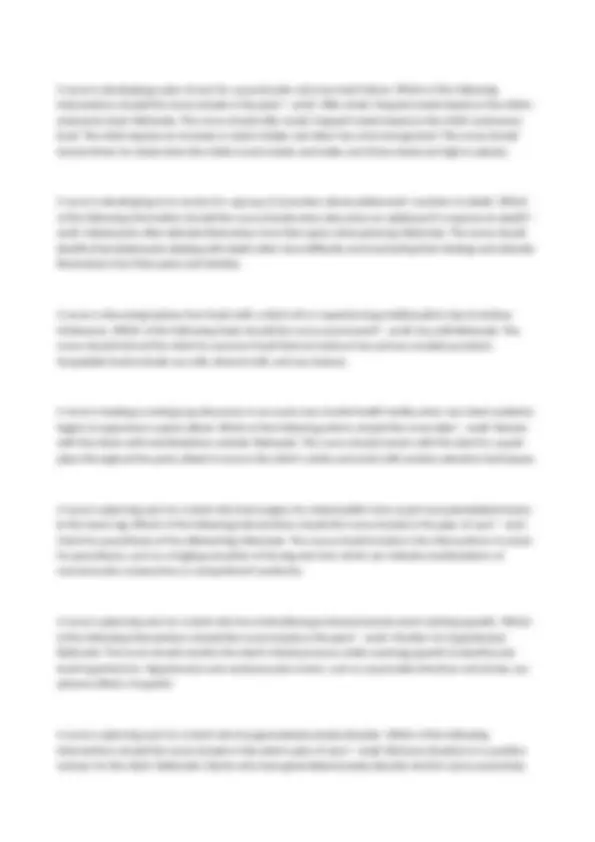
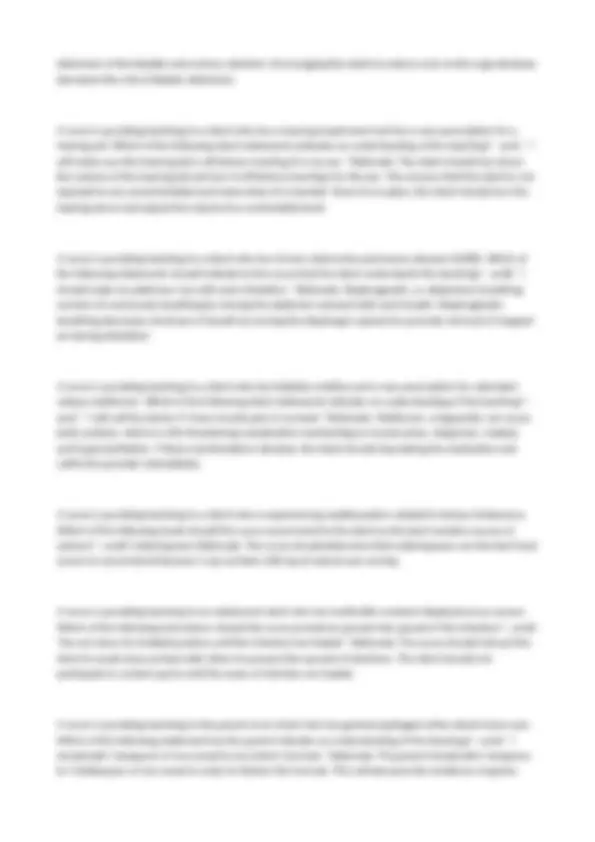
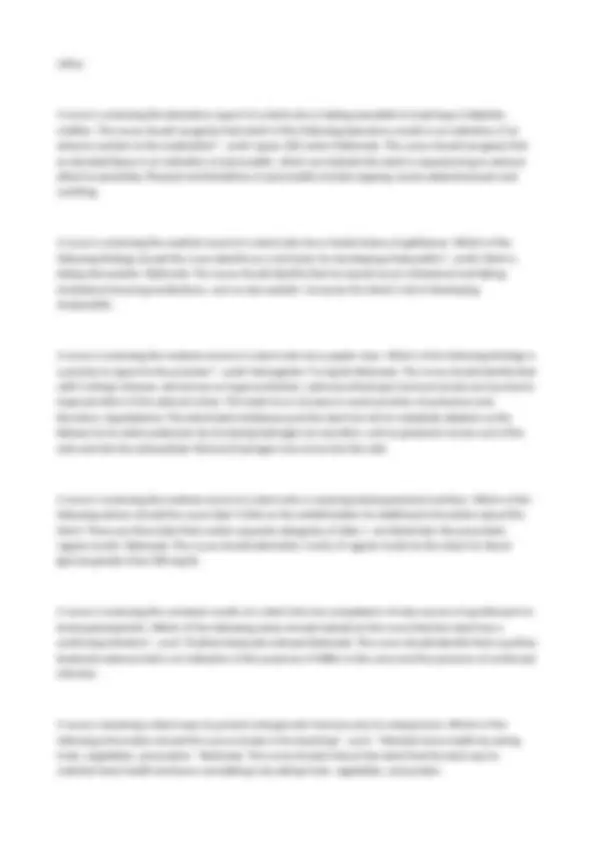
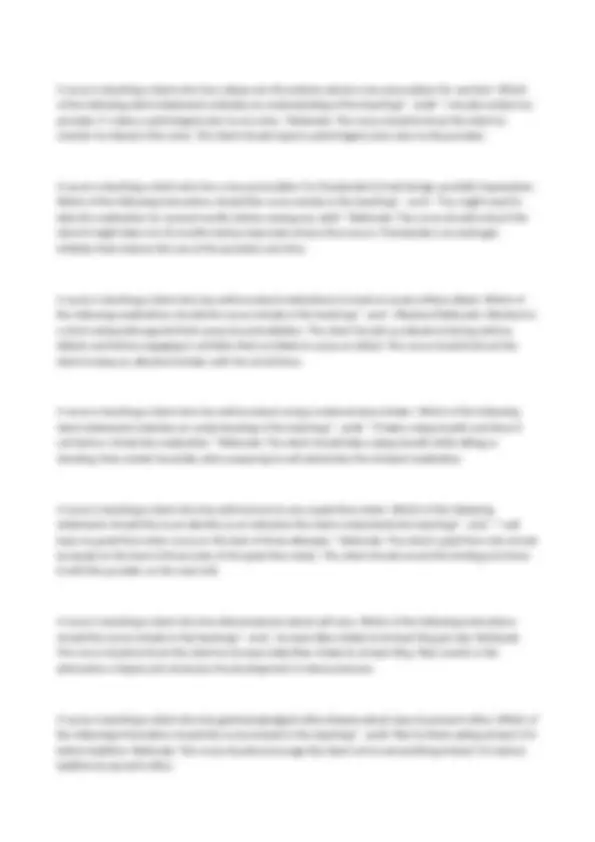
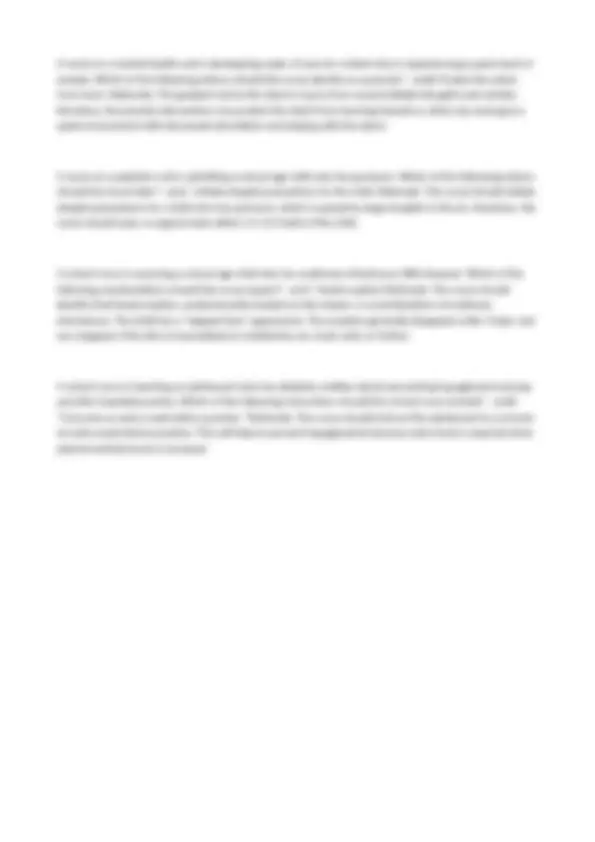


Study with the several resources on Docsity

Earn points by helping other students or get them with a premium plan


Prepare for your exams
Study with the several resources on Docsity

Earn points to download
Earn points by helping other students or get them with a premium plan
Community
Ask the community for help and clear up your study doubts
Discover the best universities in your country according to Docsity users
Free resources
Download our free guides on studying techniques, anxiety management strategies, and thesis advice from Docsity tutors
Nursing Concepts - Beginning test Questions and Answers A nurse discovers that a client who is diagnosed with dementia received the wrong medication. Which of the following should be the nurse's first action? - ansDetermine the client's condition A nurse in a local clinic is caring for a female client who is 35 years old. Which of the following screenings should the nurse recommend to the client? - ansDermatologist evaluation every 3 years to detect skin cancer. A nurse in a providers office is orientating a newly licensed nurse on how to position a client for a vaginal exam. The nurse should include in the teaching to place the client in which of the following positions? - ansLithotomy A nurse is caring for a client following a bronchoscopy. Which of the following findings requires immediate intervention? - ansDifficulty breathing
Typology: Exercises
1 / 18

This page cannot be seen from the preview
Don't miss anything!











A community health nurse is teaching a group of older adult clients about interventions to prevent pneumonia. Which of the following instructions should the nurse include in the teaching? - ansC: "Wash your hands when you return home from running errands." Rationale: The nurse should instruct clients that handwashing is one way to avoid organisms that can cause pneumonia. Handwashing after using the restroom or being in public areas can minimize the risk of developing pneumonia. A hospice nurse is caring for a preschooler who has a terminal illness. One of the child's parents tells the nurse that it is too difficult to cope any longer and has decided to move out of the house. Which of the following responses should the nurse make? - ansA: "Let's talk about a few ways you have dealt with stress in the past." Rationale: This statement by the nurse combines two therapeutic responses, active listening and focusing. Used together, these techniques facilitate communication by letting the parent know one's feelings are heard and taken seriously, which conveys acceptance and respect. Therefore, the parent feels the nurse validates the concerns and becomes comfortable asking the nurse sensitive questions about the child. A nurse has arrived at the site of an accident where a client has sustained a traumatic amputation of the big toe. Identify the sequence of steps the nurse should take to treat the musculoskeletal trauma. (Move the steps into the box on the right, placing them in the order of performance. Use all the steps.) - ansA: Call 911 and examine the amputation site. B: Apply direct pressure with layers of dry cloth .C: Elevate the extremity above the client's heart. D: Find the toe and wrap it in sterile gauze in a clean cloth. E: Place the toe in a bag and place the bag in 1 part ice and 3 parts water Rationale: The nurse should first call 911 and examine the amputation site. Next, the nurse should apply direct pressure with layers of dry cloth to slow or stop the bleeding. Then, the nurse should elevate the affected extremity above the client's heart to slow the bleeding. Next, the nurse should find the toe and wrap it in sterile gauze or a clean cloth to decrease contamination for possible surgical reattachment. Finally, the nurse should place the wrapped toe in a bag and place the bag in 1 part ice and 3 parts water to maintain tissue integrity for possible reattachment. A nurse in a provider's office is assessing a preschooler who has developed contact dermatitis following exposure to poison ivy. Which of the following statements should the nurse make to the child's parent regarding disease management? - ansD: "Place your child in an oatmeal bath using tepid water for 15 minutes." Rationale: The nurse should instruct the parent that tepid baths containing oatmeal or mineral oil can decrease itching and evenly disperse the antipruritic solution. The parent should not place the child in a hot bath as this can aggravate the child's condition and increase itching.
A nurse in a provider's office is completing a preoperative screening for a client who is scheduled for a knee arthroplasty later that week. Which of the following findings requires the nurse's intervention? (Click on the exhibit button for additional information about the client. There are three tabs that contain separate categories of data.) - ansD: Coagulation time Rationale: The nurse should report the client's coagulation time, or INR, to the provider immediately because it is above the expected reference range, which predisposes the client to intraoperative and/or postoperative hemorrhage. The nurse should expect the provider to postpone the joint arthroplasty until the client's clotting time is within the expected reference range. A nurse in an emergency department is assessing a client who has hyperthermia. Which of the following findings should the nurse identify as an indication that the client has heat exhaustion? - ansB: Vomiting Rationale: The nurse should identify that heat exhaustion is usually the result of excess sweating, leading to dehydration. Manifestations include nausea, vomiting, headache, dizziness, fainting, and a temperature typically between 38.3º C and 38.9º C (101º F and 102º F). A nurse in an emergency department is assessing a client who has type 1 diabetes mellitus. Which of the following findings should the nurse identify as an indication that the client has diabetic ketoacidosis? - ansC: Blood glucose 396 mg/dL Rationale: A client who has diabetic ketoacidosis will have a blood glucose level above 300 mg/dL. A nurse in an emergency department is assessing a client who is experiencing mild hypothermia. Which of the following manifestations should the nurse expect? - ansC: Slurred speech Rationale: The nurse should expect a client who is experiencing mild hypothermia to exhibit manifestations such as slurred speech, shivering, decreased coordination, and diuresis. A nurse in an emergency department is assessing a client who reports severe constipation. The nurse should identify which of the following findings as an indication that the client might have a small-bowel obstruction? - ansD: Visible peristaltic waves in the upper abdomen Rationale: The nurse should identify that visible peristaltic waves in the upper and middle abdomen are a manifestation of a small-bowel obstruction. The client might also have abdominal discomfort or pain. A nurse in an emergency department is assessing a preschooler who has severe dehydration as a result of gastroenteritis and is receiving isotonic IV fluids. Which of the following findings should the nurse identify as an indication that the treatment is effective? - ansD: Brisk skin turgor Rationale: The nurse should expect the child to have brisk skin turgor if fluid replacement therapy is effective. A nurse in an emergency department is caring for a client who has heat stroke. Which of the following
Which of the following manifestations should the nurse expect? - ansA: Hypoglycemia Rationale: The nurse should expect an infant who has hypothermia to have hypoglycemia. Other manifestations of hypothermia include apnea, central cyanosis, hypotonia, irritability, lethargy, weak cry or suck, poor weight gain, and hypoxia. A nurse is assessing a 3-month-old infant who has gastroenteritis with severe dehydration. Which of the following findings should the nurse expect? - ansD: Absence of tears Rationale: The nurse should expect an infant who has severe dehydration to have an absence of tears when crying. Other manifestations include tachycardia, hypotension, intense thirst, and oliguria or anuria. A nurse is assessing a client for manifestations of grief after having a colostomy for removal of colon cancer. Which of the following findings indicates to the nurse that the client has accepted the loss? - ansB: Touches the colostomy stoma when the bag is changed Rationale: The client touching the colostomy stoma when the bag is changed should indicate to the nurse that the client is accepting and coping with the alteration of body image and has gone through the stages of grief. A nurse is assessing a client who has a calcium level of 6.3 mg/dL. Which of the following findings should the nurse expect? - ansA: Circumoral tingling Rationale: The nurse should identify that hypocalcemia causes paresthesias, which is circumoral numbness and tingling of the fingers, toes, and around the mouth. A nurse is assessing a client who has a potassium level of 2.6 mg/dL and is receiving potassium chloride by continuous IV infusion. Which of the following findings should the nurse identify as an indication that the potassium infusion has brought the client's potassium level back to the expected reference range? - ansC: The client's hand grasp becomes stronger. Rationale: The nurse should identify that hypokalemia can cause a decrease of skeletal muscle strength. An improvement in the client's hand grasp indicates that the potassium chloride infusion is correcting this electrolyte imbalance. A nurse is assessing a client who has appendicitis. Which of the following findings should the nurse report to the provider immediately? - ansB: Board-like abdomen Rationale: When using the urgent vs. nonurgent approach to client care, the nurse should identify that a board-like abdomen is the priority finding indicating peritonitis. The nurse should notify the provider immediately. A nurse is assessing a client who has as an ulcer due to peripheral vascular disease. Which of the following findings should the nurse identify as an indication that the client has a venous ulcer rather than an arterial ulcer? - ansB: Discoloration and edema of the right ankle Rationale: The nurse should identify that manifestations of peripheral venous disease include discoloration and edema of the ankle, resulting from venous hypertension.
A nurse is assessing a client who has been taking antacids frequently for gastrointestinal distress. The assessment findings include drowsiness, muscle weakness, bradycardia, and hypotension. Which of the following electrolyte imbalances should the nurse suspect? - ansC: Hypermagnesemia Rationale: The nurse should identify that frequent ingestion of antacids and laxatives that contain magnesium can cause hypermagnesemia. Manifestations include hypotension, bradycardia, absent deep tendon reflexes, weak skeletal muscle contractions, ECG changes, lethargy, and drowsiness that can progress to coma. A nurse is assessing a client who has COPD and is receiving nebulized acetylcysteine. Which of the following findings should the nurse expect if the medication has been effective? - ansD: Mucus is thin and white in color. Rationale: The client who has COPD can experience manifestations of thick, tenacious secretions. White or clear mucus is an expected finding, which indicates the client is free of respiratory infection. Acetylcysteine is a mucolytic used to thin secretions and enable the client to expectorate them more easily. A nurse is assessing a client who has developed type 1 herpes simplex virus. Which of the following images should the nurse identify as this type of viral infection? - ansC: Lips with white and red sores. Rationale: Herpes simplex virus infection is a common viral infection in adults. The nurse should identify that this image indicates the type 1 herpes simplex viral infection because the infection causes a recurring cold sore. A nurse is assessing a client who has Graves' disease. Which of the following findings should the nurse expect? - ansC: Exophthalmos Rationale: The nurse should expect a client who has Graves' disease, an autoimmune form of hyperthyroidism, to experience exophthalmos, which is protrusion of the eyeballs. A nurse is assessing a client who has left-sided heart failure. Which of the following findings should the nurse expect? (Select all the apply.) - ansA: Nocturia C: Dyspnea D: Hacking cough Rationale: Left-sided heart failure causes oliguria during the day and nocturia during sleeping hours, pulmonary manifestations, such as dyspnea, orthopnea, crackles, and wheezes, and a hacking cough that worsens at night and eventually produces frothy sputum. A nurse is assessing a client who has pernicious anemia. Which of the following findings should the nurse expect? - ansA: Numbness of hands Rationale: The nurse should identify that pernicious anemia is caused by a lack of vitamin B12 and can have neurologic manifestations, such as numbness and tingling of the client's extremities. Other manifestations include pale or yellow-tinged skin, glossitis, weight loss, fatigue, and problems with balance. A nurse is assessing a client who has social phobia and reports feeling fear and panic when at social gatherings. Which of the following medications should the nurse expect the provider to prescribe? - ansC: Paroxetine Rationale: Paroxetine is a selective serotonin reuptake inhibitor that is used to treat social
quadrant to the right shoulder or scapula. A nurse is assessing a client who reports vision impairment and is diagnosed with primary open-angle glaucoma (POAG). Which of the following findings should the nurse expect? - ansA: Progressive loss of peripheral vision Rationale: The nurse should expect a client who has POAG to report a progressive loss of peripheral vision. The nurse should perform visual field testing to determine the severity of the peripheral vision loss. The nurse should also expect diagnostic assessment to indicate increased intraocular pressure. A nurse is assessing a client whose ABG results are pH 7.51, PaCO2 29 mm Hg, and HCO3 24 mEq/L. Which of the following findings should the nurse expect? - ansA: Paresthesias Rationale: One of the manifestations of respiratory alkalosis is numbness and tingling, or paresthesia, due to a decrease in calcium ionization. Other manifestations include lightheadedness, tachycardia, and cardiac dysrhythmias. A nurse is assessing a school-age child who has appendicitis with possible perforation. Which of the following findings should the nurse identify as a manifestation of peritonitis? - ansA: Abdominal distention Rationale: The nurse should identify that peritonitis is an inflammation of the lining of the abdominal wall. This inflammation, along with the ileus that develops, causes abdominal distention; therefore, the nurse should identify this as a manifestation of peritonitis. A nurse is assessing a school-age child who has diabetes mellitus and a blood glucose level of 250 mg/dL. Which of the following findings should the nurse expect? - ansB: Fruity breath odor Rationale: The nurse should expect a child who has a blood glucose level of 250 mg/dL to have a fruity or acetone breath odor. Other manifestations include lethargy, thirst, and confusion. A nurse is assessing an older adult client who is experiencing malnutrition. Which of the following findings should the nurse expect? - ansD: Brittle hair Rationale: The nurse should expect a client who is experiencing malnutrition to have dry, brittle hair, muscle wasting, a depressed mood, and poor wound healing. A nurse is assessing for manifestations of hyponatremia in a client who has been taking twice the prescribed dose of a diuretic. Which of the following findings should the nurse expect? - ansC: Decreased level of consciousness Rationale: The nurse should expect a client who has hyponatremia to have cerebral edema and increased intracranial pressure as fluid moves into the cells in the brain. This can manifest as confusion, changes in level of consciousness, and seizures. A nurse is assessing the eyes and ears of a 2-year-old toddler at a well-child visit. Which of the following findings should the nurse report to the provider? - ansB: Presence of strabismus Rationale: The nurse should recognize that the presence of strabismus, or crossing of the eyes, should disappear by 4 months of age. If this is not corrected by 4 to 6 years of age, it can lead to amblyopia; therefore, the nurse should
report this finding to the provider. A nurse is caring for a client who has a fear of open spaces. WHich of the following clinical names for this fear should the nurse document in the client's medical record? - ansB; Agoraphobia Rationale: The nurse should document that the client is experiencing agoraphobia in the client's medical record. Agoraphobia is the fear of being outside and can be debilitating and limit a client's ability to function. A nurse is caring for a client who has cellulitis of the lower extremity. Which of the following actions should the nurse take? (Select all that apply.) - ansC: Elevate the affected area 15.24 cm (6 in) above the heart E: Administer cefazolin intermittent IV bolus Rationale: The nurse should administer cefazolin intermittent IV bolus antibiotic to treat the infection associated with cellulitis & elevate the client's lower leg 15.24 cm (6 in) above the heart to decrease swelling, prevent venous stasis, and promote healing. A nurse is caring for a client who has Cushing's disease. The nurse should identify that the client is at risk for which of the following acid-base imbalances? - ansB: Metabolic alkalosis Rationale: The nurse should identify that with Cushing's disease, also known as hypercortisolism, adrenocorticotropic hormone levels are low due to hypersecretion of the adrenal cortex. This leads to an increase is renal excretion of potassium and, therefore, hypokalemia. This electrolyte imbalance puts the client at risk for metabolic alkalosis as the kidneys try to retain potassium by increasing hydrogen ion excretion, and as potassium moves out of the cells and into the extracellular fluid and hydrogen ions move into the cells. A nurse is caring for a client who has generalized anxiety disorder and is experiencing a mild level of anxiety. Which of the following manifestations should the nurse expect? - ansD: Follows directions Rationale: The nurse should expect a client who is experiencing a mild level of anxiety to be able to follow directions and focus on the nurse's instructions. Other manifestations the nurse should expect include restlessness, heightened perception, and ability to problem solve. A nurse is caring for a client who has had prolonged vomiting, has an NG tube for gastric decompression, and is receiving total parenteral nutrition. The client's ABG results are pH7.48, PaCO2 50 mm Hg, and HCO 30 mEq/L. Based on these findings, the nurse should identify that the client has which of the following acid- base imbalances? - ansA: Metabolic alkalosis Rationale: When a client is experiencing metabolic alkalosis, the pH is above the expected reference range, the PaCO2 is within or above the expected reference range, and the HCO3- is above the expected reference range. Common causes of metabolic alkalosis include overuse of antacids, prolonged vomiting, NG suctioning, total parenteral nutrition, and thiazide diuretic use. A nurse is caring for a client who has left hemiparesis following a stroke. Which of the following actions should the nurse take? - ansB: Encourage the client to use wide-grip utensils when eating with the right
A nurse is developing a plan of care for a preschooler who has heart failure. Which of the following interventions should the nurse include in the plan? - ansD: Offer small, frequent meals based on the child's endurance level. Rationale: The nurse should offer small, frequent meals based on the child's endurance level. The child requires an increase in caloric intake, but often has a low energy level. The nurse should choose times for meals when the child is most rested, and make sure those meals are high in calories. A nurse is developing an in-service for a group of coworkers about adolescents' reactions to death. Which of the following information should the nurse include when discussion an adolescent's response to death? - ansD: Adolescents often alienate themselves from their peers when grieving. Rationale: The nurse should identify that adolescents dealing with death often have difficulty communicating their feelings and alienate themselves from their peers and families. A nurse is discussing lactose-free foods with a client who is experiencing malabsorption due to lactose intolerance. Which of the following foods should the nurse recommend? - ansB: Soy milk Rationale: The nurse should instruct the client to consume foods that are lactose-free and are nondairy products. Acceptable foods include soy milk, almond milk, and soy cheeses. A nurse is leading a small group discussion in an acute care mental health facility when one client suddenly begins to experience a panic attack. Which of the following actions should the nurse take? - ansB: Remain with the client until manifestations subside. Rationale: The nurse should remain with the client in a quiet place throughout the panic attack to ensure the client's safety and assist with anxiety reduction techniques. A nurse is planning care for a client who had surgery for osteomyelitis from a past musculoskeletal trauma to the lower leg. Which of the following interventions should the nurse include in the plan of care? - ansC: Check for paresthesia of the affected leg. Rationale: The nurse should include in the interventions to check for paresthesia, such as a tingling sensation of the leg and foot, which can indicate manifestations of neurovascular compromise or compartment syndrome. A nurse is planning care for a client who has chemotherapy-induced anemia and is starting epoetin. Which of the following interventions should the nurse include in the plan? - ansD: Monitor for hypertension. Rationale: The nurse should monitor the client's blood pressure while receiving epoetin to identify and treat hypertension. Hypertension and cardiovascular events, such as myocardial infarction and stroke, are adverse effects of epoetin. A nurse is planning care for a client who has generalized anxiety disorder. Which of the following interventions should the nurse include in the client's plan of care? - ansB: Reframe situations in a positive manner for the client. Rationale: Clients who have generalized anxiety disorder tend to worry excessively
about the impact of various situations and events. Reframing them positively offers the client a fresh perspective and helps adjust his thought distortions. A nurse is planning care for a client who has pneumonia. WHich of the following interventions should the nurse include in the plan? - ansC: Teach the client how to cough up secretions. Rationale: The nurse should instruct the client how to cough and breathe deeply to expel productive secretions and clear the airway for optimal breathing. A nurse is planning care for a client who has renal calculi. Which of the following interventions should the nurse include to promote elimination of the calculi? - ansC: Encourage intake of at least 3 L of fluid each day. Rationale: The nurse should encourage the client to consume at least 3 L of fluid each day. Increased fluid intake increases urine production, promotes eliminiation of calculi, and helps prevent recurrence. A nurse is planning care for a client who is postoperative and has developed left lower leg deep-vein thrombosis. Which of the following interventions should the nurse include in the plan of care? - ansC: Make sure the client's legs are elevated while in bed. Rationale: The nurse should ensure the client elevates her legs in bed and wears antiembolic stockings to help prevent venous insufficiency. A nurse is planning care to prevent hospital-acquired methicillin-resistant Staphylococcus aureus (MRSA) infection for a client who is immunocompromised. Which of the following interventions should the nurse include to prevent this antibiotic-resistant infection? - ansB: Bathe the client with chlorhexidine wipes. Rationale: The nurse should bathe a client who is immunocompromised with chlorhexidine wipes to decrease the risk of contracting hospital-acquired MRSA. A nurse is providing dietary teaching for a client who has hyperlipidemia due to nephrotic syndrome. Which of the following instructions should the nurse include in the teaching? - ansA: Less than 30% of daily calories should come from fat. Rationale: The nurse should instruct the client to choose foods low in fat and ensure that less than 30% of her daily total caloric intake is from fat. Limiting daily fat intake will improve lipid levels. A nurse is providing discharge planning for a client who has gestational diabetes. Which of the following interventions should the nurse identify as a priority? - ansA: Determine the client's knowledge regarding gestational diabetes. Rationale: The first action the nurse should take when using the nursing process is to assess the client. It is important for the nurse to determine the client's knowledge level regarding the disease process. This provides the nurse with information regarding where to start with the client teaching process. A nurse is providing discharge teaching for a client who had lithotripsy to break up calculi in the right
distension of the bladder and urinary retention. Encouraging the client to void as soon as the urge develops decreases the risk of bladder distension. A nurse is providing teaching to a client who has a hearing impairment and has a new prescription for a hearing aid. Which of the following client statements indicates an understanding of the teaching? - ansC: "I will make sure the hearing aid is off before inserting it in my ear." Rationale: The client should turn down the volume of the hearing aid and turn it off before inserting it in the ear. This ensures that the client is not exposed to any uncomfortably loud noise when it is inserted. Once it is in place, the client should turn the hearing aid on and adjust the volume to a comfortable level. A nurse is providing teaching to a client who has chronic obstructive pulmonary disease (COPD). Which of the following statements should indicate to the nurse that the client understands the teaching? - ansB: "I should make my abdomen rise with each inhalation." Rationale: Diaphragmatic, or abdominal, breathing consists of consciously breathing by moving the abdomen outward with each breath. Diaphragmatic breathing decreases shortness of breath by moving the diaphragm upward to promote removal of trapped air during exhalation. A nurse is providing teaching to a client who has diabetes mellitus and a new prescription for extended- release metformin. Which of the following client statements indicates an understanding of the teaching? - ansC: "I will call the doctor if I have muscle pain in my back." Rationale: Metformin, a biguanide, can cause lactic acidosis, which is a life-threatening complication manifesting as muscle aches, sleepiness, malaise, and hyperventilation. If these manifestations develop, the client should stop taking the medication and notify the provider immediately. A nurse is providing teaching to a client who is experiencing malabsorption related to lactose intolerance. Which of the following foods should the nurse recommend to the client as the best nondairy source of calcium? - ansB: Collard greens Rationale: The nurse should determine that collard greens are the best food source to recommend because 1 cup contains 268 mg of calcium per serving. A nurse is providing teaching to an adolescent client who has methicillin-resistant Staphylococcus aureus. Which of the following instructions should the nurse provide to prevent the spread of this infection? - ansD: "Do not return to football practice until the infection has healed." Rationale: The nurse should instruct the client to avoid close contact with others to prevent the spread of infections. The client should not participate in contact sports until the areas of infection are healed. A nurse is providing teaching to the parent of an infant who has gastroesophageal reflux about home care. Which of the following statements by the parent indicates an understanding of the teaching? - ansD: "I should add 1 teaspoon of rice cereal to my infant's formula." Rationale: The parent should add 1 teaspoon to 1 tablespoon of rice cereal in order to thicken the formula. This will decrease the incidence of gastric
reflux. A nurse is reviewing the laboratory report of a client who is taking exenatide to treat type 2 diabetes mellitus. The nurse should recognize that which of the following laboratory results is an indication of an adverse reaction to the medication? - ansD: Lipase 185 units/L Rationale: The nurse should recognize that an elevated lipase is an indication of pancreatitis, which can indicate the client is experiencing an adverse effect to exenatide. Physical manifestations of pancreatitis include ongoing, severe abdominal pain and vomiting. A nurse is reviewing the medical record of a client who has a family history of gallstones. Which of the following findings should the nurse identify as a risk factor for developing cholecystitis? - ansB: Client is taking atorvastatin. Rationale: The nurse should identify that increased serum cholesterol and taking cholesterol-lowering medications, such as atorvastatin, increases the client's risk of developing cholecystitis. A nurse is reviewing the medical record of a client who has a peptic ulcer. Which of the following findings is a priority to report to the provider? - ansB: Hemoglobin 7.6 mg/dL Rationale: The nurse should identify that with Cushing's disease, also known as hypercortisolism, adrenocorticotropic hormone levels are low due to hypersecretion of the adrenal cortex. This leads to an increase is renal excretion of potassium and, therefore, hypokalemia. This electrolyte imbalance puts the client at risk for metabolic alkalosis as the kidneys try to retain potassium by increasing hydrogen ion excretion, and as potassium moves out of the cells and into the extracellular fluid and hydrogen ions move into the cells. A nurse is reviewing the medical record of a client who is receiving total parenteral nutrition. Which of the following actions should the nurse take? (Click on the exhibit button for additional information about the client. There are three tabs that contain separate categories of data.) - ansAdminister the prescribed regular insulin. Rationale: The nurse should administer 3 units of regular insulin to the client for blood glucose greater than 200 mg/dL. A nurse is reviewing the urinalysis results of a client who has completed a 14-day course of ciprofloxacin to treat pyelonephritis. WHich of the following values should indicate to the nurse that the client has a continuing infection? - ansC: Positive leukocyte esterase Rationale: The nurse should identify that a positive leukocyte esterase test is an indication of the presence of WBCs in the urine and the presence of continued infection. A nurse is teaching a client ways to prevent osteoporotic fractures due to osteoporosis. Which of the following information should the nurse include in the teaching? - ansA: "Maintain bone health by eating fruits, vegetables, and protein." Rationale: The nurse should instruct the client that the best way to maintain bone health and bone remodeling is by eating fruits, vegetables, and protein.
A nurse is teaching a client who has hypertension and a new prescription for atenolol. Which of the following information should the nurse include in the teaching? - ansD: "You should contact your provider if your pulse rate drops below 60 per minute." Rationale: The nurse should teach the client how to monitor his pulse rate and further instruct the client to withhold the medication and notify his provider if his pulse rate drops below 60/min. A nurse is teaching a client who has hypothyroidism about taking levothyroxine. Which of the following statements should the nurse make? - ansB: "This medication causes adverse effects if the dosage is too high or too low." Rationale: The nurse should instruct the client that levothyroxine, in the right dosage, does not typically cause adverse effects. If the dosage is too low, the manifestations of hypothyroidism will recur. If the dosage is too high, the manifestations of hyperthyroidism will occur. A nurse is teaching a client who has scabies about a new prescription for lindane lotion. Which of the following client statements indicates an understanding of the treatment for this parasitic infection?C: "I will wash the lotion off 12 hours after I apply it." - ansC: "I will wash the lotion off 12 hours after I apply it." Rationale: The nurse should instruct the client to apply the lotion and leave it in place for 8 to 12 hr and then remove it by washing it off. A nurse is teaching a client who has tuberculosis about taking rifampin. Which of the following instructions should the nurse include? - ansB: "Do not drink alcohol while taking this medication." Rationale: The nurse should instruct the client that rifampin could cause liver damage. Alcohol intensifies this risk. Rifampin is contraindicated for clients who have liver disease or consume alcohol in excess. A nurse is teaching a client who has type 1 diabetes mellitus about actions to take when having manifestations of hypoglycemia with a glucometer reading between 40 and 60 mg/dL. Which of the following instructions should the nurse include? - ansD: Drink 120 mL (4 oz) of fruit juice. Rationale: The nurse should instruct the client to drink 120 mL (4 oz) of fruit juice, which will provide 10 to 15 g of carbohydrates to treat the hypoglycemia. A nurse is teaching a client who is at moderate risk for osteoporosis about ways to help prevent this chronic disease. Which of the following instructions should the nurse include? (Select all that apply.) - ansB: Increase dairy product intake. C: Engage in weight-bearing exercises regularly. E: Reduce excessive caffeine intake Rationale: To help prevent osteoporosis, the client should increase weight-bearing exercises, such as walking, but should avoid activities that are jarring to the musculoskeletal system, such as jogging and horseback riding, the client should increase her dietary intake of dairy products, which are a good source of calcium, and the client should limit her intake of caffeine and alcohol.
A nurse is teaching a female adult client who is obese about disease management. Which of the following information should the nurse include in the teaching? - ansC: Morbid obesity is measured as a BMI over 40. Rationale: The nurse should instruct the client that the expected reference range for a healthy weight is a BMI of 25 or less. A client who has a BMI of 40 or greater is considered morbidly obese. A nurse is teaching a male client who has hypertension about dietary guidelines to help manage his disorder. Which of the following instructions should the nurse include? - ansA: Reduce sodium intake to 1,500 mg/day or less. Rationale: The nurse should instruct the client to keep his daily sodium intake below 1,500 mg/day. Reducing sodium intake can lower both systolic and diastolic blood pressure. A nurse is teaching about foot care with a group of older adults who have type 1 diabetes mellitus. Which of the following information should the nurse include in the teaching? - ansD: Trim toenails straight across to prevent ingrown toenails. Rationale: The nurse should instruct the clients to trim toenails straight across to prevent ingrown toenails that increase the risk for tissue breakdown and infection. A nurse is teaching about herbal supplements with a group of newly licensed nurses. Which of the following herbal supplements should the nurse include in the teaching for treating hyperlipidemia? - ansD: Garlic Rationale: The nurse should include that garlic can help improve cholesterol levels, which then helps to reduce the buildup of plaque in the arteries. For some clients, it can also help lower blood pressure A nurse is teaching an older adult client who has peripheral neuropathy about a new prescription for duloxetine. Which of the following client statements indicates an understanding of the teaching? - ansA: "It might take several weeks to notice an improvement in my symptoms." Rationale: The nurse should instruct the client that duloxetine can take several weeks to be effective. This medication is an antidepressant that reduces the discomfort of peripheral neuropathy. A nurse is teaching disease management techniques to a client who has COPD. Which of the following instructions should the nurse include in the teaching? - ansB: Use pursed-lip breathing when feeling short of breath. Rationale: The nurse should instruct the client how to use diaphragmatic and pursed-lip breathing to control breathing when feeling dyspneic. A nurse is teaching the parent of a school-age child who has pediculosis capitis about treating this parasitic infestation. Which of the following instructions should the nurse include? - ansA: Wash bedding, clothes, and towels in hot water in a washing machine. Rationale: The nurse should instruct the parent to wash all cloth items the child has been in contact with in hot water and dry them on a hot setting in a clothes dryer for 20 min. This helps kill any lice or nits in these items.